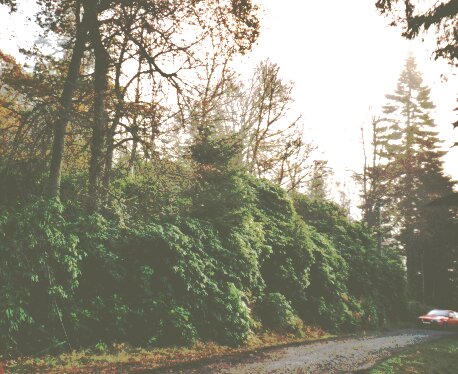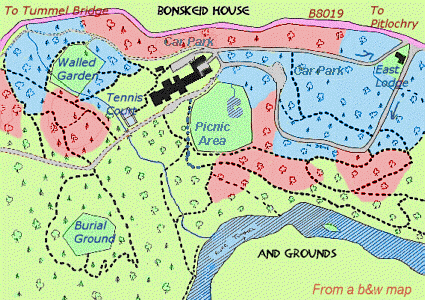
During Stephen Pratt's period as the last Woodland Manager of YMCA Bonskeid House, rhododendron clearing was an essential part of the woodland management, as well as knowledge of all the trees and their conservation. This report is slightly edited from the original Bonskeid website.
The Importance of Strategy and Commitment in Reducing Dense Layered Rhododendron Cover in Amenity Woodlands
An On-going Working Study
Carried Out at YMCA Bonskeid House, Nr Pitlochry 1995 to 2000
Background
The Grounds of YMCA Bonskeid House encompassed 38 acres (15 hectares) of specimen policy woodland and semi-native woodland on steep and rocky ground.
Planting policy began in the late 18th Century with seed and plants from the first of species introduced here such as European Larch (1860), Douglas Fir (1826), Wellingtonia (1853), Grand Fir, Silver Fir, Western Hemlock and many other interesting species - as well as the introduction of Rhododendron Ponticum and Japanese Knotweed.
Rhododendron Ponticum became an invasive species which knows no bounds. In over a hundred years the rhododendrons have reached 24ft in height and cover approximately 85% of the Grounds. Reaching into inaccessible gullies and overhanging rock outcrops.

Rhodendron thrives in acid soil and damp ground and there are no natural checks and balances which control the growth and invasive nature of the plant. The soil and ground beneath the plant is rendered a sterile undercarpet and at Bonskeid it became impossoble to find any competing flora or fauna. Dense layered rhododendron ponticum attracts little wild life other than as a shelter belt for a growing population of Roe Deer.

Conservation programme
A conservation programme to reduce and eliminate rhododendron cover began in 1995. A Woodland Improvement Grant was applied for and granted on 5 Nov 1997.


Aim
The aim of the programme was to eradicate rhododendron cover throughout the policy and native woodland leaving a raked seed bed from which to obtain selective natural regeneration.
Natural regeneration
Rhododendron removal
in:| a) | the policy woodland creates space for the continuation of specimen exotic species by way of a varied age structure through selective natural regeneration and some planting where necessary |
| b) | in the semi-native woodland and birch woodland - alongside the control of invasive species such as beech, sycamore and Douglas Fir - provides space for the continuation of a balance of semi-native woodlands. |
Time of Year
Rhododendron removal is best suited to Autumn and Winter in order to make and take advantage of a clean uncontaminated seedbed in the Spring.
Strategy
The total area was divided into a number of topographical zones – this enables practical and realistic control and completion of each area – to create a systematic eradication. If Rhododendron is cut back the result is more vigorous growth the following year. Hence the need for strategy and commitment to finish each zone before moving onto the next area.
Volunteer Labour
It is a fallacy to think that volunteer labour is the answer to rhododendron control. This mind-set has led to under funding and lack of serious intent by authorities to support or recognise the true cost in time and effort of such an operation.
Volunteer labour however can be an important part of the process if used as part of an on-going strategy to get into inaccessible areas such as steep gullies, raking off, cleaning up after a machine, and in establishing and protecting regeneration with tree guards. In order to get the maximum value out of this work and to get a finished job, the work must be supervised by an on-site manager.
Cut, Rake, Gather, Burn and a Final Rake
This is the process by which the Rhododendron is removed and a seed bed created.
Tracked Digger
At YMCA Bonskeid House we have used a variety of machines and methods. There is no quick and easy method of taking out rhododendron, but Bonskeid found the most efficient machines to be the tracked diggers such as the Kubota 191 six ton machine (for restricted areas), and the Fiat-Hitachi 12 ton with a 6 metre reach for larger areas. The larger machine was able to roll and crush the brash prior to burning. Operator knowledge of the structural growth of the plant was essential to enable full eradication of the plant without leaving underground suckers. Knowledge of the ground was also important to obtain the best safe working practice. Care was taken around existing trees and minimum damage to the ground was also a requirement. This all took time and was dependent on maintaining a methodical, steady approach clearing small areas at a time ideally leaving a finished seed bed without further intervention.
Natural Regeneration
After one year the result of natural regeneration was stunning. Every kind of native tree regeneration was in abundance including Penduncular Oak, Scots Pine, Hazel, Ash, Rowan. Bonskeid also found that the new regeneration required protection from deer after the first year.
Amenity Woodlands
These had a high profile with the public and therefore Bonskeid had to clear up after each operation. The much publicised flail mower was not acceptable in this location and would not have touched many of the inaccessible areas such as deep rock crevasses and gullies within the woodland.
Stump Removal
Where practically possible stumps were removed and burned.
Regrowth
Rhododendron regrowth from stumps or shoots which are not removed were sprayed with the systemic agent Roundup + Mixture B (the sticking agent) from a knapsack sprayer after 2 or 3 years of regrowth had taken place. This enabled the mixture to pass into the whole plant. Spraying regrowth was an on-going management operation.
Conclusion
Conservation work was expensive in terms of labour and cost, with no monetary return. Few land owners are in the position to commit resources to such a time consuming and costly exercise. After five years steady and systematic clearance work Bonskeid estimated 60% towards completion of rhododendron eradication, so that the woodland had a future.
How the woodland continues to be managed will be a matter for the new private owner. Adrian Worsfold.
Acknowledgements
The conservation programme could not have been undertaken without a Woodland Improvement Grant from the Forestry Commission. Bonskeid thanked staff from the Perth Conservancy for their advice, support and encouragement.
See also Forestry Commission Bulletin 73 "Rhododendron Ponticum as a Forest Weed" by Tabbush and Williamson (1987).
Stephen Pratt
Adrian Worsfold
Woodland Manager
© 1999, 2001